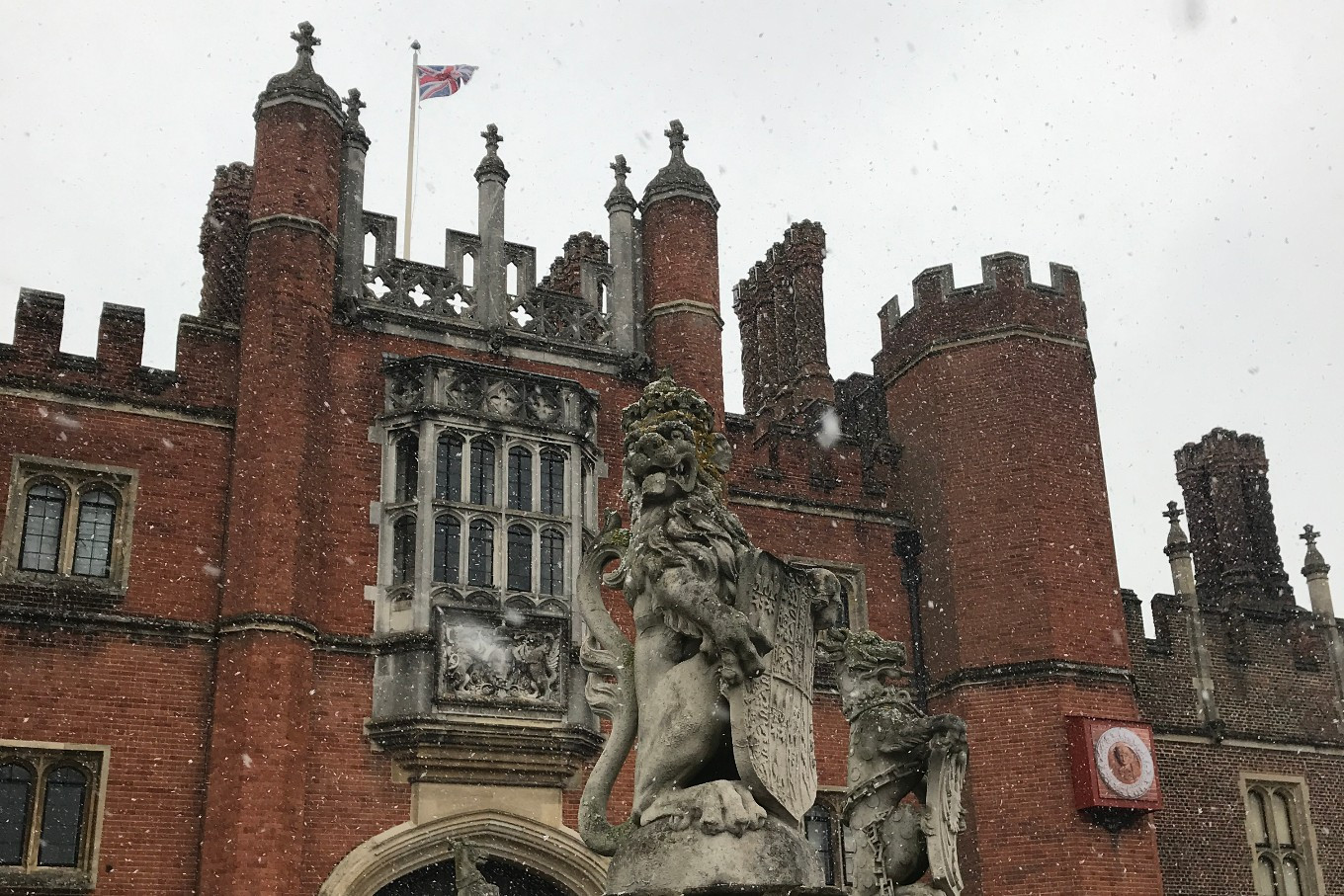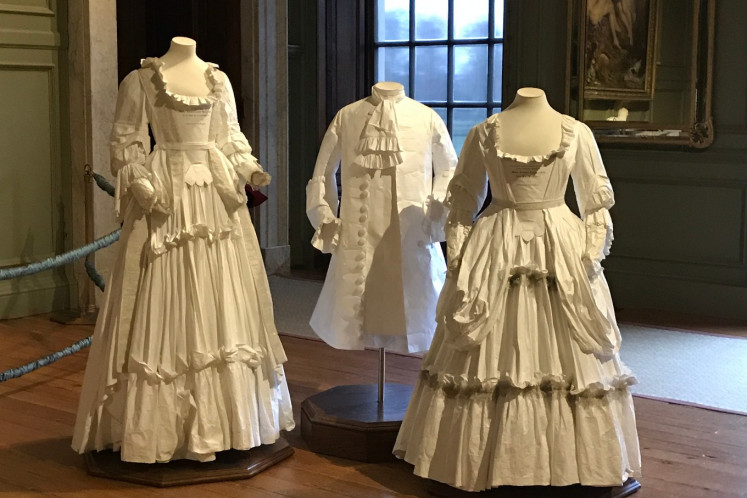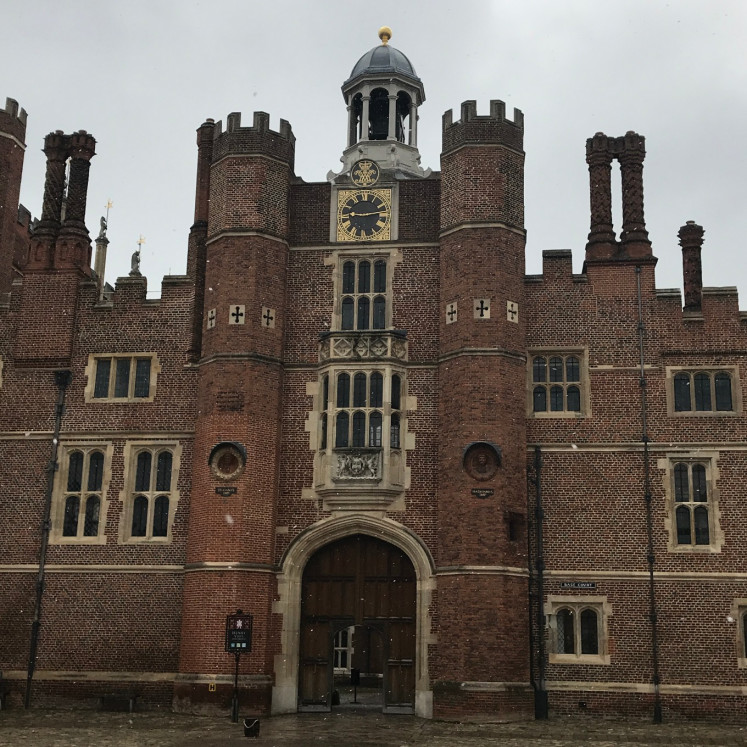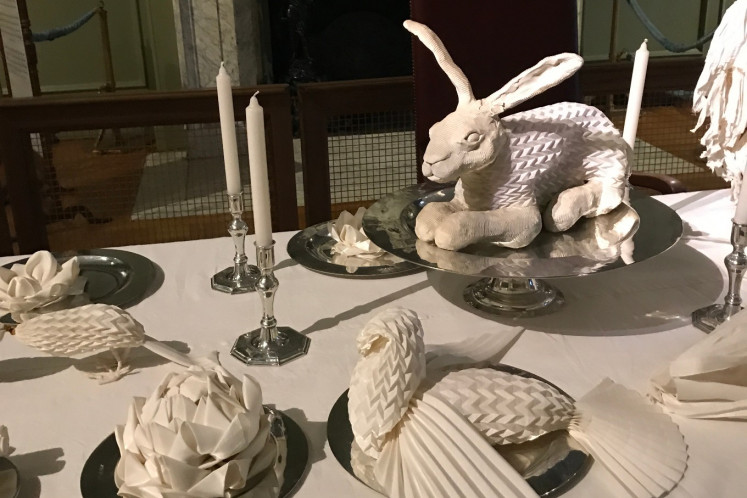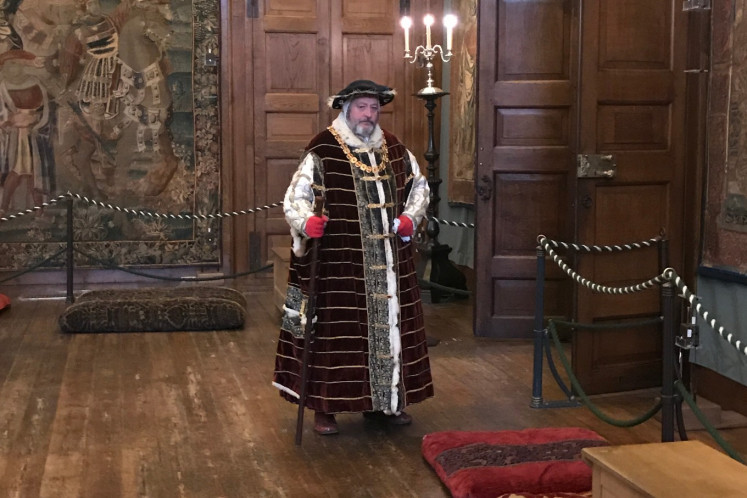Popular Reads
Top Results
Can't find what you're looking for?
View all search resultsPopular Reads
Top Results
Can't find what you're looking for?
View all search resultsRetracing England's regal past in Hampton Court
One can imagine the palace staff as they went back and forth to keep the fire going for the diners to keep warm or refilled their wine and ale glasses.
Change text size
Gift Premium Articles
to Anyone
T
he logs lay within a freestanding rectangular grill in the middle of Hampton Court’s Great Hall, much like they did during the palace’s heyday in the 16th century.
One can imagine the palace staff as they went back and forth to keep the fire going for the diners to keep warm or refilled their wine and ale glasses. Jesters, jugglers and other acts wended their way around the hall and diverted the courtiers with their prancing and jokes.
The monarch, most notably King Henry VIII, presided over the glittering court from a long table. The king hovered on a raised platform above such luminaries as the dukes of Norfolk and Suffolk.
One of his six queens, among them the unfortunate Anne Boleyn and Catherine Howard, would dine beside him. Both queens and other members of his court would learn the hard way that the unpredictable king was as likely to execute his nobles as he would party with them.
Henry’s paranoia was best reflected in the wooden effigies that peered from the Great Hall’s wooden ceiling. Known as eavesdroppers, the statues reminded the courtiers that their words and thoughts were constantly overheard.
Inception of the palace
The Great Hall is one of the major parts of Hampton Court Palace. Located in the Greater London borough of Richmond, the palace served as one of the residences for England’s Tudor, Stuart and Hanoverian monarchs from the 16th to 18th centuries.
However, the palace owed its inception in 1514 to Henry VIII’s Lord Chancellor Cardinal Thomas Wolsey. “Wolsey wanted to create a grand building where he could host not only the King and the royal court, but also monarchs from across Europe,” noted Historic Royal Palaces in its website www.hrp.org.uk.
But Wolsey did not enjoy his dream home for long because of his declining political fortunes. He handed the palace over to Henry in 1528 after he failed to convince the Vatican to annul Henry’s marriage to his first queen Catherine of Aragon.
Henry made Hampton Court his showpiece palace and a web with him at its very center. “Henry wanted anyone who came to Hampton Court to be dazzled by his wealth and power,” said Historic Royal Palaces.
Henry and his courtiers might be long gone, replaced by smartphone-toting tourists wandering its corridors. Yet, his portraits and a rather mournful impersonator wearing the court costumes of his era keep his memory alive.
Hanoverian era costumes in Fountain Court (JP/Tunggul Wirajuda)Wolsey’s touch can be seen in Hampton Court’s Italian Renaissance and medieval styles, which were similar to its contemporary, the Chateau de Chambord, in France. While Hampton Court’s red bricks give the palace a more subdued look that contrasted with Chambord’s marble opulence, it is no less striking.
The towers of the main entrance, along with the 10 statues of lions, unicorns and other heraldic animals on either side of the walkway, make walking into Hampton Court a striking experience. Known as the King’s Beasts, the animals represent Henry’s ancestors and that of his third queen Jane Seymour. The entrance to the inner courtyard known as the Clock Tower or Anne Boleyn’s Gate is no less intricate. The structure features the Hampton Court Clock, which still functions since it was installed in 1540. Aside from telling the time, the clock also shows the phases of the moon and water levels of the Thames, among other things.
The Clock Tower (JP/Tunggul Wirajuda)The Great Hall
No place in Hampton Court epitomizes Henry VIII’s outsized appetites more than the Great Hall and nearby Great Kitchen. One is dwarfed by the latter’s cave-like structure and huge grill, as befitting a kitchen that served up to 1,600 meals a day for the hundreds of courtiers at the Great Hall. Yet the room is more than a banqueting hall.
Details of Stuart or Hanoverian dining table in the Fountain Court (JP/Tunggul Wirajuda)“[The Great Hall is] England’s last and greatest medieval hall, and one of the United Kingdom’s oldest theaters,” said Historic Royal Palaces. “In 1603, William Shakespeare’s ‘King’s Men’ first performed Hamlet and Macbeth for the new Stuart king James I [...] James was also responsible for organizing the 1604 Hampton Court Conference that resulted in the publication of the King James Bible in 1611.”
The Great Hall continues to be a historic venue nearly 500 years on. In October 2005, then-prime minister Tony Blair hosted an informal meeting of European Union heads of state and government there.
The Chapel Royal
The vivid blue ceiling overhangs the chapel altar under it. Adorned with golden stars and rectangular corners, the ornate layout captures one’s imagination. The words “Dieu et mon Droit” (God and my Right) emblazons the ceiling, much as it has since Henry VIII commissioned the structure in the 1530s. “A captivating chapel in continuous use for over 450 years,” Historic Royal Palaces noted of the Chapel Royal.
A look at the varnished wooden pews and organ, many of which were designed by famed 17th architect Christopher Wren for Queen Anne, the last of the Stuart monarchs, shows that the Chapel Royal fitted its bill perfectly. Yet the serene surface belies the palace’s more sinister goings on, one of which involved Henry’s fifth queen Catherine Howard before her execution for adultery in 1542.
“It is claimed that after [Catherine Howard] was arrested at Hampton Court, the terrified teenager broke free of her guards. She ran along what is now called the Haunted Gallery, screaming out to the king [Henry VIII] for mercy,” said Historic Royal Palaces. “She never reached Henry, who was at prayer in the Chapel […] It is said that her anguished ghost now repeats this heartbreaking journey, screaming through eternity.”
Henry VIII reenactor (JP/Tunggul Wirajuda)The Fountain Court
Compared to the medieval and Renaissance ostentation of the Great Hall, Chapel Royal and other Tudor parts of Hampton Court, the Fountain Court used by the Stuart and Hanoverian monarchs are more formal and subdued. Built by Wren for William III and his queen Mary II between 1689 and 1694, this section of Hampton Court was built on the site of Henry VIII’s state apartments.
The contrast between the Tudor and Stuart palaces is reflected in the more enclosed, intimate dining rooms. This can be seen in the reproductions of Stuart and Hanoverian era costumes, as well as the linen tablecloths shaped as rabbits, swans and other animals.
William stamped his mark with the painting Victory of Alexander over the 12 Caesars on the grand staircase leading to the apartment. Painted by the Italian artist Verrio, the work symbolized the Protestant William’s takeover of England from his unpopular Catholic father-in-law King James II during the Glorious Revolution of 1688.
The State Apartments include the Guard Chamber and its striking weapons collection, the Presence Chamber that contains his throne, and the Privy Chamber where courtiers and statesmen close to the king attended to him.
Other Stuart legacies include Hampton Court’s world-famous gardens, vines and maze, as well as the Long Water canal built by Charles II in the 1660s. Hampton Court continues to make an impact after it was discontinued as a royal residence by the Hanoverian king George II in 1737.
Aside from hosting the annual Hampton Court Music Festival that featured the likes of Sir Elton John and soprano Dame Kiri Te Kanawa, the palace was also used as one of the locations for the Hollywood film The Favourite starring Olivia Colman, Rachel Weisz and Emma Stone.
But whether one is keen on spectacle or just a day to stroll through its venerable corridors, Hampton Court has no shortage of surprises. (kes)

